For years, I’ve navigated the world of outdoor adventures on a shoestring. Whether it was due to unexpected bills, a bike mishap, or a spontaneous trip, budget constraints have often pushed me to be resourceful. Now, a retail giant, Walmart, is stepping into the gravel bike market, aiming to break down the price barrier significantly.
Following their surprisingly well-received budget mountain bike line under the Ozark Trails brand last year, Walmart has now introduced its first gravel bike, the Ozark Trail G.1 Explorer. This drop-bar, 29-inch wheel bike, complete with versatile mounting points, is priced under $250. Positioned to be available in Walmart’s widespread budget-friendly bike sections, it has the potential to significantly impact the entry-level adventure cycling scene.
Naturally, I had to get my hands on one. Days before these bikes were set to appear in stores, I found myself in Bentonville, Arkansas, Walmart’s headquarters, picking up a brand-new Ozark Trail G.1 Explorer.
My mission? To traverse the Ozarks, exploring hundreds of miles of newly established bikepacking routes around Fayetteville. These routes are part of the city’s initiative to embrace the growing cycling culture fostered by nearby Bentonville and Walmart. My journey to Little Rock would serve as a real-world test for the new Ozark Trail bike, uncovering its strengths and weaknesses along the way.
In essence: After putting this bike through a rigorous 300-mile test, starting from Walmart’s backyard and heading towards Arkansas’ capital, I discovered a mix of positives and negatives. While the brakes were a cause for concern and the drivetrain presented some challenges, the abundance of mounting points was a pleasant surprise, outdoing even some pricier bikes I’ve ridden. The most compelling aspect, however, is the price point, prompting the question: Will the Ozark Trail G.1 Explorer revolutionize the cycling industry?
Ozark Trail G.1 Explorer: Key Specifications
- Weight: 30.4 lbs
- Fork: Steel, quick release with mounts for added versatility
- Frame: 6061 aluminum, designed for durability and lightness
- Sizes: Small and medium, accommodating 29” tires
- Drivetrain: L-TWOO 2×7, paired with Shimano Tourney rear derailleur for reliable shifting
- Handlebar: Drop bar; 400mm top width with a comfortable 15-degree flare
- Stock tires: Kenda 700x40c, featuring soft gum sidewalls for enhanced grip
- Stack: 560 mm (medium), optimized for a balanced riding posture
- Reach: 395 mm (medium), ensuring comfortable reach for various rider sizes
- Wheelbase: 1,034 mm (medium), providing stability on diverse terrains
- Fork geometry: 72-degree head tube; 63mm trail, engineered for responsive handling
Pros
- Unbeatable budget-friendly price point, making gravel biking accessible to more people
- Front fork mounts, increasing its utility for bikepacking and adventure riding
- Well-rounded gravel riding geometry, suitable for varied terrains
- Handlebar flare is appropriately designed for gravel riding comfort
Cons
- Brakes feel underpowered and potentially unsafe in demanding situations
- Shifting is stiff, impacting the smoothness of gear changes
- Frame weight is on the heavier side, affecting overall bike agility
- Stock tires are prone to flats, especially in rough conditions
Ozark Trail G.1 Explorer: Initial Thoughts
My first impression upon seeing the Ozark Trail G.1 Explorer was related to its sizing. The medium frame I received for testing had a stack height of about 56cm and a reach of approximately 40cm. As someone who is just under 6 feet tall, typically riding a large frame due to long arms and legs, I was initially concerned about the medium size. However, given my shorter torso, I found that the medium Explorer could work for a few hundred miles of testing. It’s worth noting that Walmart offers this model only in small and medium sizes, which might limit its appeal for taller riders.
What immediately caught my attention were the bike’s mounting points. I’ve encountered many gravel, touring, and adventure bikes, often at much higher price points, that offer fewer mounting options. The Ozark Trail G.1 Explorer pleasantly surprised me with three mounting points within the main triangle for water bottles, plus additional front fork mounts perfect for racks or cages. This feature made it easy to attach my trusted Old Man Mountain Pizza and Divide racks, instantly boosting its bikepacking potential.
This abundance of mounts is not just practical; it’s also economically smart, aligning perfectly with Walmart’s budget-conscious ethos. Riders looking to save money can utilize racks with dry bags, affordable panniers, or even repurposed trunk bags they might already own, rather than investing in pricier, trendy bikepacking-specific bags.
While my rack choices might not have been the absolute cheapest, the principle held true. I opted for my most seasoned and well-used trunk bags and panniers, emphasizing the bike’s capability to work with basic, affordable gear.
The geometry of the Explorer also seemed to take a straightforward, classic gravel approach. With a 72-degree head tube angle, approximately 44mm of fork offset, 440mm chainstays, and a wheelbase around 1,035mm, the bike’s dimensions suggested a conventional gravel geometry design. The handlebar drops appeared somewhat deep, but the 15-degree flare offered a reasonable level of comfort and control.
First Ride Impressions
“I’ve heard about that bike, but haven’t actually seen one yet,” remarked the mechanic at Phat Tire, a local bike shop. “For better or worse, that bike is definitely going to shake things up for a lot of people.” With those words and a few extra inner tubes packed into my frame bag, I embarked on the first ride to test the Ozark Trail G.1 Explorer gravel bike.
Fayetteville is undeniably a cycling-centric city. The 40-mile paved Razorback Greenway trail runs through its heart, and numerous other trails branch off, ranging from gentle paths to more technical routes with sharp turns under bridges, often shared with pedestrians. I had three days to explore these trails before venturing into the Ozark backcountry.
The Kenda tires, seemingly inspired by Kenda’s Booster Pros, performed adequately on paved surfaces, making my commutes smooth. However, considering my total weight with gear—camera equipment, racks, bags, fishing gear, and more—reaching about 265 pounds, I knew the soft sidewalls would require higher pressure to prevent bottoming out on rougher terrain.
The shifting, while stiff, was surprisingly consistent. I could comfortably maintain speeds up to 26 mph on flat roads and gentle downhills. Uphill, however, presented a different scenario.
The 2×7 L-TWOO drivetrain offered a limited gear range. For entry-level consumers, prioritizing consistent shifting over a wider range with budget components is a reasonable compromise. Yet, as I pedaled the Ozark Trail gravel bike up the first steep paved incline, being overtaken by cyclists training for the U.S. Mountain Bike Pro Cup, I realized I’d be doing more pushing than riding on the Ozark hills.
One concern emerged quickly: the brakes. While I anticipated needing some adjustment, achieving effective stopping power without constant rotor rub proved challenging. Hauling 265 pounds, I foresaw potentially precarious descents ahead.
Challenges on the Trail: Steep Climbs and Rocky Descents
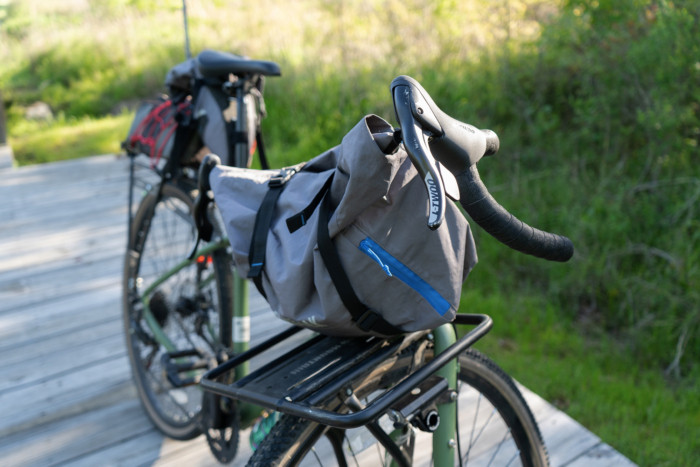 Handlebars of the Ozark Trail G.1 Explorer, showing the flared drop bars designed for gravel riding
Handlebars of the Ozark Trail G.1 Explorer, showing the flared drop bars designed for gravel riding
The initial two days of trail riding were admittedly demanding. I was testing the bike on 50 miles of an uncompleted bikepacking route ascending a mountain—a tough test for any bike, especially a budget model. Adding to the challenge, I came down with strep throat on day one.
Despite these hurdles, the Explorer’s frame held up well. Its slight flex felt appropriate given the heavy load I was carrying. The front fork struck a good balance, being slack enough for stability yet responsive enough to avoid feeling sluggish with the added weight of gear and water.
The front cockpit was a mixed bag. The hoods offered decent comfort, but the drops felt a bit too deep for anything but smooth descents. On rougher trails, I found myself wishing for wider handlebars. However, this was not my primary concern.
Within those first two days, the limitations of the brakes, drivetrain, and tires became apparent on steep ascents and descents composed of roughly 50% gravel and 50% golf-ball to baseball-sized rocks. This terrain was pushing the bike’s components beyond their intended capabilities.
The Explorer is adequately geared for bikepacking in gentle hill country and for unloaded rides on moderately steep terrain. However, the approach to the Ozarks’ White Rock mountain was far from moderate. Feeling increasingly ill, I ended up pushing the Explorer up several miles of hills that I would typically ride on most gravel bikes.
Two flat tires in as many days further complicated matters. The Kenda tires might have been enjoyable on more consistent, hard-packed gravel. But with nearly 300 pounds of total weight on trails littered with sharp rocks, downhill sections inevitably led to bottoming out and pinch flats.
By the second day, braking on descents became genuinely unnerving. Between tire repairs, worsening illness, and falling behind schedule for an eclipse viewing, I lacked the time to properly adjust the brakes. This resulted in some white-knuckle descents at speeds around 15 mph.
Finding the Sweet Spot: Milder Terrains
Plan B became essential. Weaker and running low on tire patches, I made a strategic decision. The remaining 200 miles of the journey would reroute to a mix of paved roads and harder-packed gravel roads closer to major highways. Instantly, flat tires ceased to be an issue without the larger, sharp rocks.
On these milder surfaces—dirt, gravel, and paved roads—the drivetrain began to make more sense. The constant pushing was over, and the limited gear range ironically helped mitigate the stiff shifting by necessitating smaller gear jumps.
After approximately 125 miles of hard riding, the brakes and front derailleur required some attention with an Allen wrench to readjust. Post-adjustment, neither component operated flawlessly (and the brakes remained somewhat noisy), but they became dependably functional.
I concluded the extended adventure ride with three days of regular city commuting. The Explorer proved to be a surprisingly nimble and practical bike for navigating urban environments.
Value and Verdict on the Ozark Trail G.1 Explorer
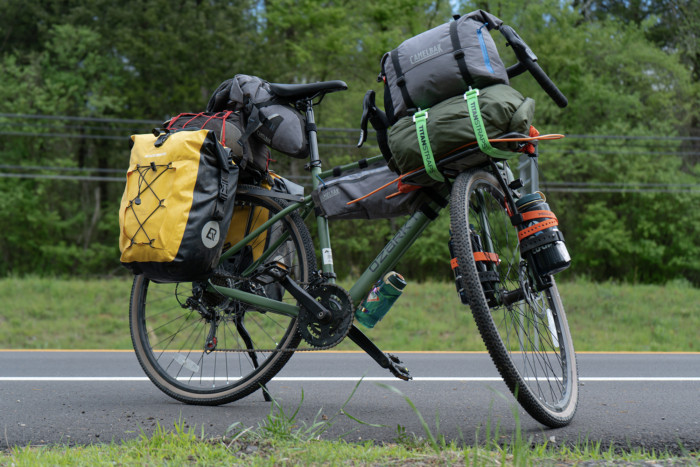 The Ozark Trail G.1 gravel bike in an urban setting, highlighting its versatility and accessibility
The Ozark Trail G.1 gravel bike in an urban setting, highlighting its versatility and accessibility
The defining feature of the Ozark Trail G.1 Explorer is its Manufacturer’s Suggested Retail Price (MSRP) of $248. This price is lower than some high-end handlebars or saddles alone.
Reflecting on my experiences, the Ozark Trail G.1 Explorer certainly has its drawbacks. The shifting, braking, tires, and other components were, at times, frustrating and even a bit alarming.
However, this Walmart Gravel Bike successfully carried a 265-pound rider and gear load through the Ozarks for under $250. That is a remarkable feat.
Many of the noted shortcomings become less significant with lighter loads and less aggressive terrain. While it’s true that some performance aspects are merely adequate for seasoned cyclists accustomed to bikes costing ten times as much, and yes, the Ozark Trail G.1 Explorer is only available in two sizes, it’s important to consider the target audience.
For beginner adventurers or those on a strict budget, the Explorer is undeniably capable. It stands out as one of the most readily accessible gravel bikes on the market. Despite any refinement it might lack, the blend of availability, functionality, and an incredibly low price—where some bike components cost more—makes the Ozark Trail Explorer G.1 a genuine contender for budget-conscious adventurers and, as the local bike mechanic predicted, a potential “shake up” in the cycling world.
[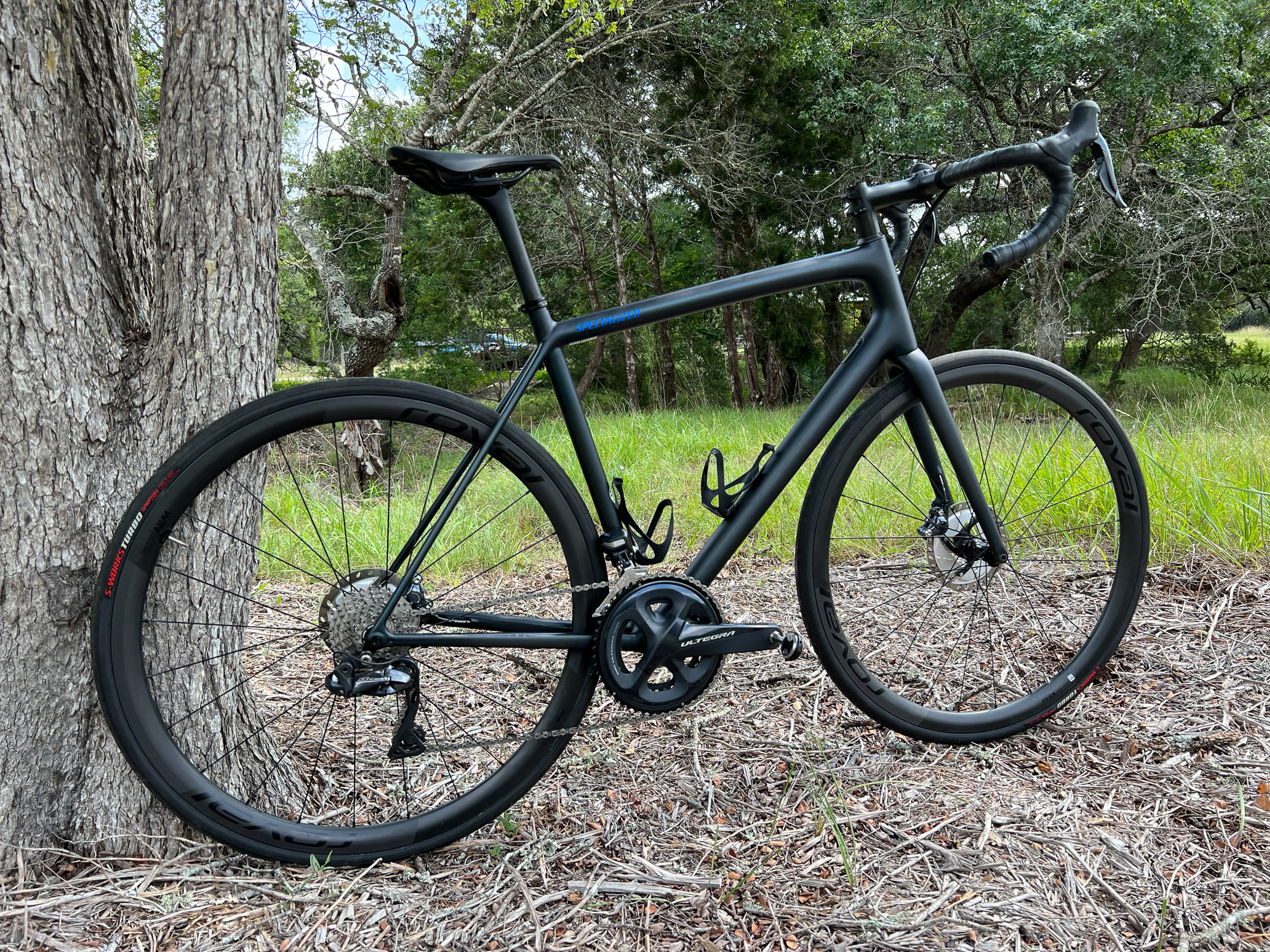 Specialized Aethos Pro Road Bike Review – A high-end comparison to illustrate the value proposition of budget bikes
Specialized Aethos Pro Road Bike Review – A high-end comparison to illustrate the value proposition of budget bikes
Mythical and Mesmerizing Road Feel: Specialized Aethos Pro Road Bike Review
If ride quality is your top priority, the Specialized Aethos Pro will astound you. Its road feel is mesmerizing, unlike any other road bike. Read more…

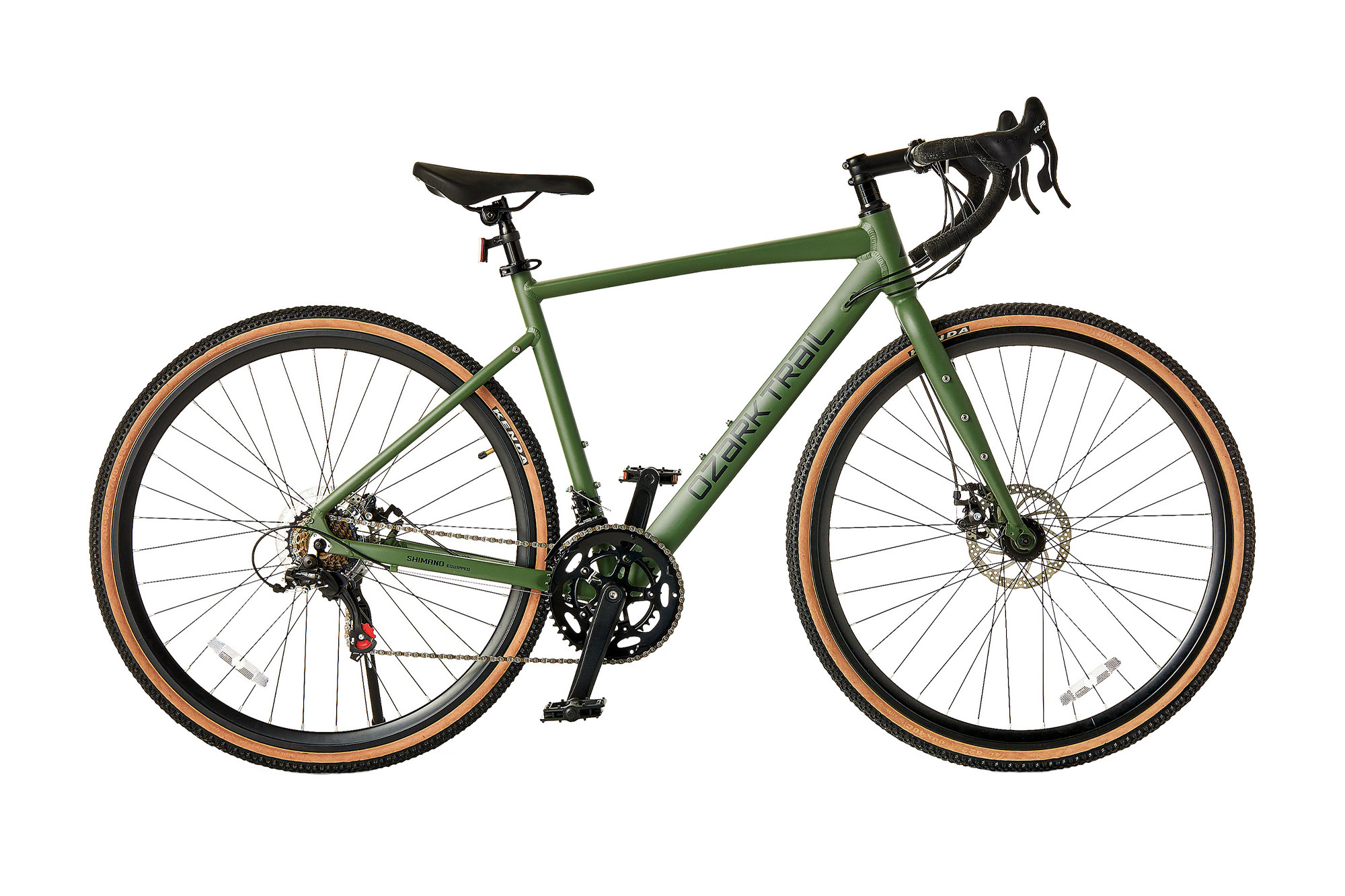
 Close up of the front fork mounts on the Ozark Trail G.1 Explorer, highlighting its bikepacking readiness
Close up of the front fork mounts on the Ozark Trail G.1 Explorer, highlighting its bikepacking readiness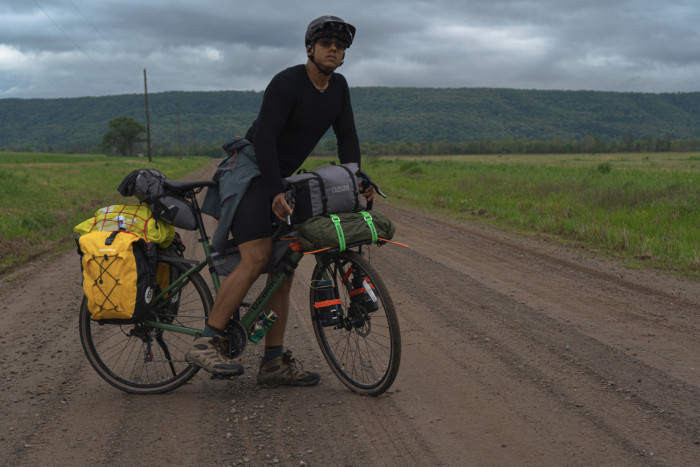 Author taking the Ozark Trail G.1 Explorer out for its inaugural ride, showcasing its gravel bike design
Author taking the Ozark Trail G.1 Explorer out for its inaugural ride, showcasing its gravel bike design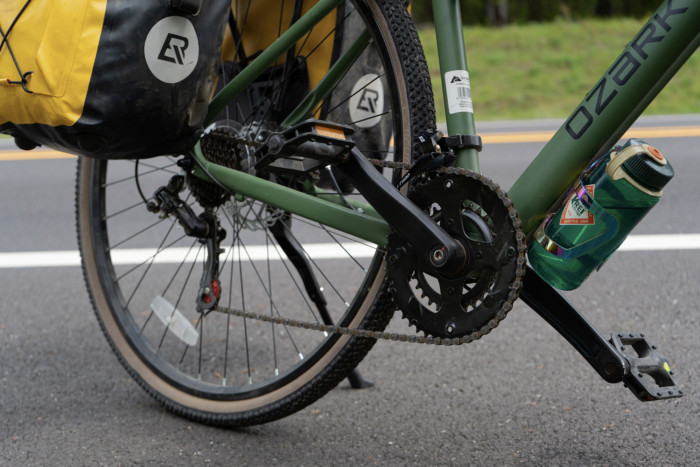 Drivetrain components of the Ozark Trail G.1 Explorer, showcasing the L-TWOO and Shimano Tourney setup
Drivetrain components of the Ozark Trail G.1 Explorer, showcasing the L-TWOO and Shimano Tourney setup